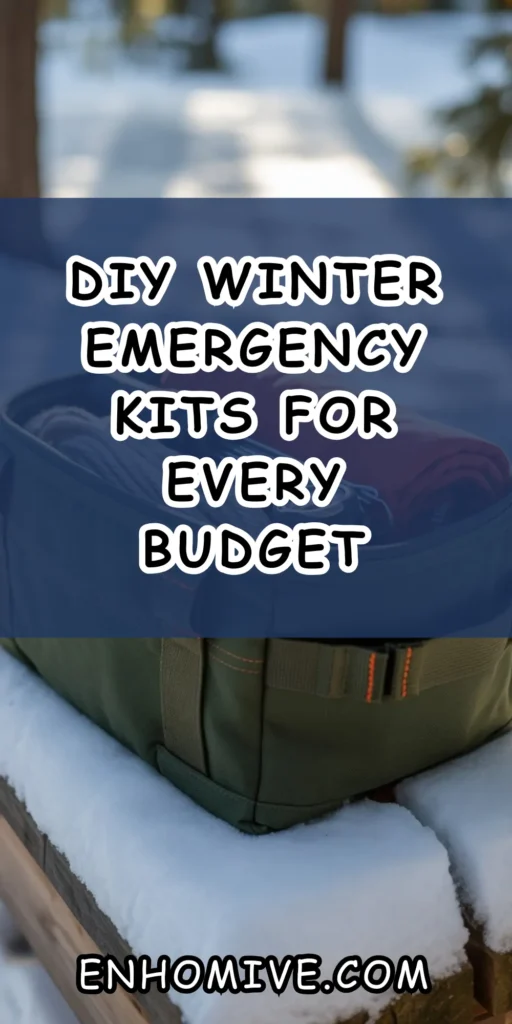DIY Winter Emergency Kits for Every Budget
When winter hits hard, a well-stocked emergency kit can make all the difference between a cozy evening and a cold, stressful night. Whether you live in a snowy area or just want to be ready for power outages, ice storms, or freezing temperatures, having a winter kit on hand ensures you’re safe, warm, and comfortable — without spending a fortune.
Here’s how to build the perfect DIY winter emergency kit for any budget, plus what to include for home, car, and personal use.

Why You Need a Winter Emergency Kit
Winter weather can be unpredictable — snowstorms, black ice, and power cuts can happen suddenly. A prepared kit keeps you self-sufficient for at least 72 hours, covering basics like warmth, food, water, lighting, and first aid.
Even small investments now can save you hundreds in emergencies — and maybe even your life.
The Essentials Every Winter Kit Should Include
No matter your budget, every winter emergency kit should contain these key items:
- Warmth: Blankets, thermal socks, gloves, hand warmers, and extra layers
- Light & Power: Flashlights, candles, matches, and a battery or solar charger
- Food & Water: Non-perishable foods, protein bars, nuts, bottled water, or a water filter
- First Aid: Basic medical supplies, prescription medications, and pain relievers
- Tools: A multi-tool, duct tape, shovel, and car scraper
- Communication: A charged power bank or emergency radio
- Hygiene: Wipes, tissues, and small trash bags
These are your non-negotiables — then, you can scale up depending on budget.
Budget-Friendly Kit (Under $50)
Perfect for college students, renters, or anyone just starting their prep. You can create a solid emergency kit with essentials found at discount stores or using things you already own.
Include:
- 2 thick blankets or thrifted sleeping bags
- Battery flashlight and spare batteries
- Reusable water bottles
- Instant noodles, granola bars, and canned soup
- Dollar-store first aid kit
- Hand warmers and gloves
- Candles with matches
- Notebook and pen for emergency notes
This version won’t break the bank but will keep you safe in a short-term winter outage.
Mid-Range Kit (Around $100–$150)
This level adds durability and convenience — ideal for families or frequent travelers.
Include:
- Emergency space blankets and fleece throws
- LED lantern or solar light
- Power bank with charging cable
- Compact first aid kit with antiseptic wipes and bandages
- Thermal water bottles and instant coffee
- Portable stove with fuel tablets
- Shovel and ice scraper
- Energy snacks, nuts, and canned beans
- A whistle and small emergency radio
This setup gives you warmth, food, and reliable lighting for up to three days.
Premium Kit (Over $200)
For those who want full security and comfort during long power cuts or travel disruptions.
Include:
- Heavy-duty insulated sleeping bags
- Solar-powered generator or crank charger
- LED lanterns with backup batteries
- Emergency freeze-dried meals
- Full medical-grade first aid kit
- Waterproof matches and fire starters
- Multi-tool and durable snow shovel
- Heated gloves or blankets
- Portable propane heater (for well-ventilated areas only)
It’s an investment in long-term safety, ideal for cold climates or remote areas.
Car Winter Kit Essentials
Even a quick drive can turn risky in snow. Keep a car-specific kit ready in your trunk.
Must-haves:
- Small shovel and traction sand or kitty litter
- Ice scraper and windshield fluid
- Jumper cables and tow rope
- Blanket, gloves, and hat
- Flashlight with extra batteries
- High-protein snacks and bottled water
- Emergency flares or reflectors
- Portable phone charger
A compact version can fit neatly in a bin — perfect for winter commutes or road trips.
Home Comfort Add-Ons
If your power goes out, comfort makes all the difference.
Consider adding:
- Board games or books for downtime
- Battery-powered candles or fairy lights for cozy lighting
- Instant hot cocoa or soup mixes
- A small indoor-safe heater
- Extra pet supplies (if you have animals)
Keeping spirits up matters as much as staying warm.
Cost Comparison: DIY vs Store-Bought Kits
| Type | DIY Estimated Cost | Store-Bought Kit | Key Difference |
|---|---|---|---|
| Basic Kit | $40–$50 | $80–$100 | DIY is cheaper, but requires effort to assemble |
| Mid-Range | $120 | $180–$220 | More personalized and durable |
| Premium | $200–$250 | $300+ | Store kits often include unnecessary items |
DIY kits save money while giving you control over what’s truly useful for your lifestyle.
Pro Tips for Winter Prep
- Store your kit in an easy-to-access spot (near entryway or car trunk)
- Check supplies twice a year — especially batteries, food, and medication
- Label bags clearly for “home” and “car”
- Keep one small kit near your bed — power outages often happen at night
Quick Grab Checklist
For Home:
☐ Blankets or sleeping bags
☐ Flashlight and extra batteries
☐ Bottled water (1 gallon per person per day)
☐ Non-perishable food (3-day supply)
☐ First aid kit
☐ Candles and matches
☐ Battery or solar charger
☐ Warm gloves, hats, and socks
For Car:
☐ Ice scraper and small shovel
☐ Jumper cables
☐ Blanket and spare gloves
☐ Flares or reflectors
☐ Energy bars and water
☐ Tow rope and sand/kitty litter
☐ Power bank or charger
Optional Comfort Items:
☐ Books, games, or puzzles
☐ Pet food and supplies
☐ Instant coffee, cocoa, or soup
☐ Lantern or fairy lights
Final Thought: Preparedness Is Peace of Mind
You don’t need to spend hundreds to stay safe and warm this winter. A DIY emergency kit ensures that when snow, ice, or power loss hit unexpectedly, you’re calm, ready, and comfortable — no panic, no stress.






